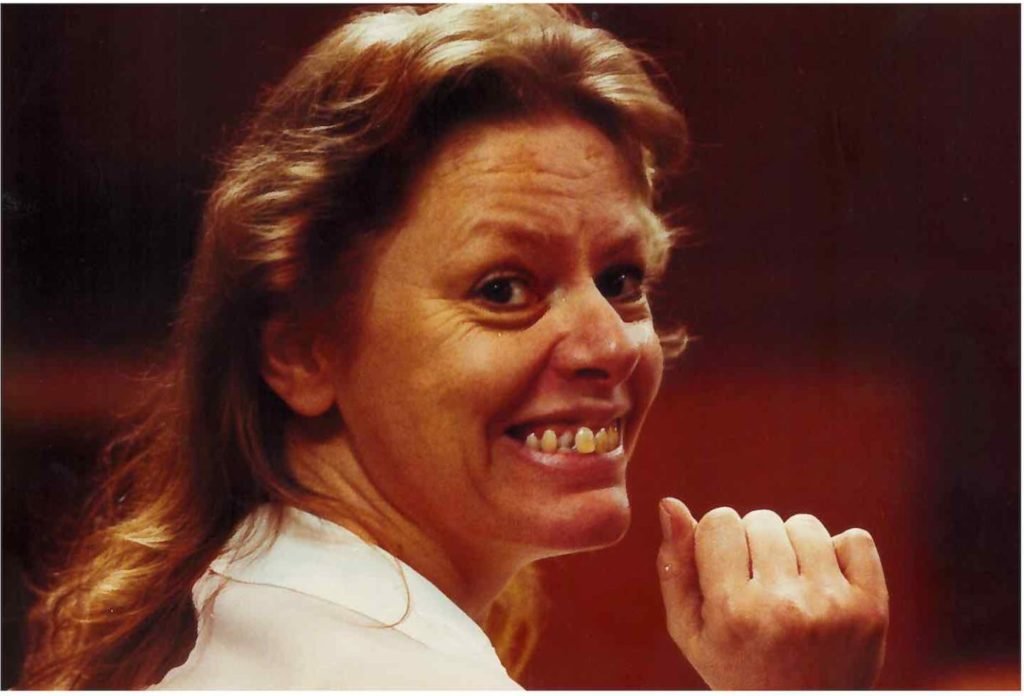Aileen Wuornos: Not a Monster
/Content Warning: this post contains content about sexual violence. Please take care when reading.
You may have heard of Aileen Wuornos: branded as America’s first female serial killer, unrepentant sexual deviant and psycho killer, Monster. In the early ‘90s, that’s how Wuornos was portrayed by the media and law enforcement after she was arrested for the murder of seven men. It was the same angle pursued by the prosecution when Wuornos was on trial in 1992 for first-degree murder. Aileen Wuornos was convicted by a jury and sentenced to death. She spent a decade on death row until she was executed by lethal injection on October 9th, 2002.
It was easy to call Wuornos an evil murderer and do away with her. But I don’t think Aileen Wuornos was disposable. I don’t think a traumatized, mentally ill woman deserved a state-sanctioned death. I am not trying to absolve her from the crimes she committed. Instead, I’d like to try and understand Wuornos for who she really was: a person who was exploited her entire life, and failed by every system that could have prevented her from becoming what she did.
Image courtesy of unherd.com
Wuornos was born into a life of violence and poverty. Her mother was just 14 years old when she gave birth. Her father was in prison for raping a child when she was born. He later hung himself in jail. When she was four years old, Wuornos and her brother were abandoned by their mother. They went to live with their alcoholic and abusive grandparents.
Her already difficult life only got worse. She was repeatedly raped by her grandfather and other family members. She began survival sex work at 11-years-old. Like her mother, she gave birth at 14, after being raped. She put the baby up for adoption and was kicked out of her home. I won’t belabour the point any further: from the time she was born, her life was hell. She was abused and failed by every person who was supposed to take care of her.
It didn’t stop after she turned 14. Wuornos continued to do survival sex work into her adult life. She was in and out of jail her entire life, from the first time she was arrested as a teenager. She’d been a ward of the state, though she was often homeless, and committed various drunken and petty crimes. There were plenty of opportunities for the state to step in and provide her with the rehabilitation, counselling and healthcare Wuornos so desperately needed. Instead, she was churned out and spit back onto the street after every arrest and stint in jail. Instead, she was discarded by a system that saw her as worthless.
Feminist writer Phyllis Chesler tried to organize a thorough defense that addressed the decades of abuse and poverty that put Wuornos on the path to murder: “I organized a pro bono team of experts to testify about violence against prostitutes and a prostitute’s right to defend herself. I hoped we could also address the level of complex, post-traumatic stress from which she and all prostitutes suffer…none of us were ever called.”
IMAGE COURTESY OF IMDB
“Aileen was terrorised by violent johns, and eventually lashed out in crazed defense, just like men do in wars when they are also afraid of getting killed or tortured,” said psychologist Melissa Farley, who worked on Wuornos’ case. None of this was mentioned in the media at the time of her trial, much less considered by the prosecution or jury as potential mitigating factors in her crimes. She was treated as a throw away—a dirty prostitute who killed men to rob them of their cash and cars. Wuornos maintained that each killing was done in self-defense throughout her trial, though as her mental state deteriorated, she claimed to enjoy the killing. Perhaps she did. It may have been the only time in her life that she felt in control.
The first man Wuornos killed, Richard Mallory, was a convicted rapist. Like her other six victims, he was a ‘john’, a term used to describe men who hire sex workers. Wuornos said he beat and raped her, which lead to her shooting him in self-defense. That was November 30th, 1989. In the next year, she would sporadically shoot and kill six more ‘johns’. The murders did not seem coordinated or planned, and she maintained all were in self-defense.
“People painted Aileen as a monster,” said Wuornos’ defense attorney Nick Broomfield, “which she was not. She was also not a serial killer. Aileen neither planned her crimes, stalked her victims, or took any pleasure from what she did.”
Wuornos’ story has been retold by many different people, in many ways, for different reasons. Most seek to exploit her trauma for financial gain. Some portrayals are sympathetic, such as the Oscar-winning performance by Charlize Theron, who played Wuornos in the film Monster. The movie humanizes her, but like the title suggests, it turns her into a monstrosity as well. Other feminist writers have tried to understand and humanize Wuornos. Journalist Julie Grindel says in her examination of Wuornos’ life and crimes, “there are monsters…and there are misrepresentations.”
My name is Angie Mosher (she/her) and I'm a Professional Writing student at Algonquin College. I have a Bachelor of Arts in Creative Writing from UBC, and when I’m not writing, I’m playing video games, hanging out with my cats, or getting a new tattoo. I’m originally from Halifax, Nova Scotia, but have been living in Ottawa since 2017. I like shining a light on things otherwise left to rot in the corner. Let’s kick up some dust.





